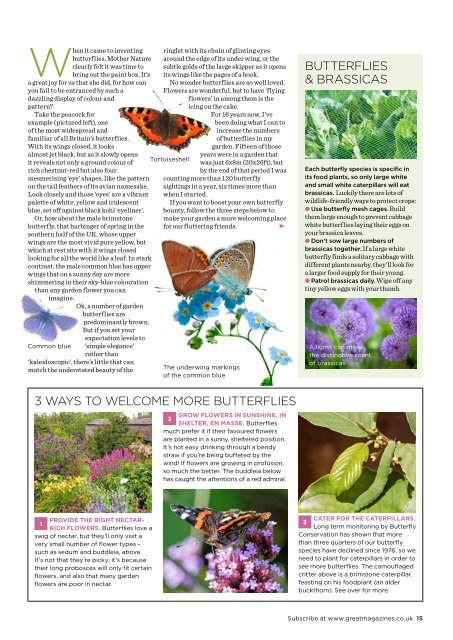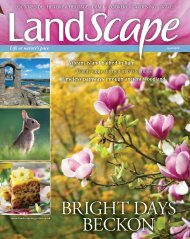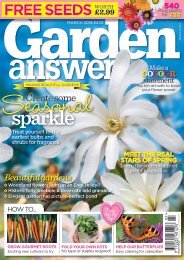Garden Answers Mini-Mag
Get a taste of the lovely Garden Answers magazine with this free sampler!
Get a taste of the lovely Garden Answers magazine with this free sampler!
You also want an ePaper? Increase the reach of your titles
YUMPU automatically turns print PDFs into web optimized ePapers that Google loves.
When it came to inventing<br />
butterflies, Mother Nature<br />
clearly felt it was time to<br />
bring out the paint box. It’s<br />
a great joy for us that she did, for how can<br />
you fail to be entranced by such a<br />
dazzling display of colour and<br />
pattern?<br />
Take the peacock for<br />
example (pictured left), one<br />
of the most widespread and<br />
familiar of all Britain’s butterflies.<br />
With its wings closed, it looks<br />
almost jet black, but as it slowly opens<br />
it reveals not only a ground colour of<br />
rich chestnut-red but also four<br />
mesmerising ‘eye’ shapes, like the pattern<br />
on the tail feathers of its avian namesake.<br />
Look closely and those ‘eyes’ are a vibrant<br />
palette of white, yellow and iridescent<br />
blue, set off against black kohl ‘eyeliner’.<br />
Or, how about the male brimstone<br />
butterfly, that harbinger of spring in the<br />
southern half of the UK, whose upper<br />
wings are the most vivid pure yellow, but<br />
which at rest sits with it wings closed<br />
looking for all the world like a leaf. In stark<br />
contrast, the male common blue has upper<br />
wings that on a sunny day are more<br />
shimmering in their sky-blue colouration<br />
than any garden flower you can<br />
imagine.<br />
Ok, a number of garden<br />
butterflies are<br />
predominantly brown.<br />
But if you set your<br />
Common blue<br />
expectation levels to<br />
‘simple elegance’<br />
rather than<br />
‘kaleidoscopic’, there’s little that can<br />
match the understated beauty of the<br />
ringlet with its chain of glinting eyes<br />
around the edge of its under wing, or the<br />
subtle golds of the large skipper as it opens<br />
its wings like the pages of a book.<br />
No wonder butterflies are so well loved.<br />
Flowers are wonderful, but to have ‘flying<br />
flowers’ in among them is the<br />
icing on the cake.<br />
For 16 years now, I’ve<br />
been doing what I can to<br />
increase the numbers<br />
of butterflies in my<br />
garden. Fifteen of those<br />
years were in a garden that<br />
was just 6x8m (20x26ft), but<br />
by the end of that period I was<br />
counting more than 120 butterfly<br />
sightings in a year, six times more than<br />
when I started.<br />
If you want to boost your own butterfly<br />
bounty, follow the three steps below to<br />
Tortoiseshell<br />
make your garden a more welcoming place<br />
for our fluttering friends.<br />
➤<br />
The underwing markings<br />
of the common blue<br />
BUTTERFLIES<br />
& BRASSICAS<br />
Each butterfly species is specific in<br />
its food plants, so only large white<br />
and small white caterpillars will eat<br />
brassicas. Luckily there are lots of<br />
wildlife-friendly ways to protect crops:<br />
l Use butterfly mesh cages. Build<br />
them large enough to prevent cabbage<br />
white butterflies laying their eggs on<br />
your brassica leaves.<br />
l Don’t sow large numbers of<br />
brassicas together. If a large white<br />
butterfly finds a solitary cabbage with<br />
different plants nearby, they’ll look for<br />
a larger food supply for their young.<br />
l Patrol brassicas daily. Wipe off any<br />
tiny yellow eggs with your thumb.<br />
Alliums can mask<br />
the distinctive scent<br />
of brassicas<br />
3 WAYS TO WELCOME MORE BUTTERFLIES<br />
GROW FLOWERS IN SUNSHINE, IN<br />
2<br />
SHELTER, EN MASSE. Butterflies<br />
much prefer it if their favoured flowers<br />
are planted in a sunny, sheltered position.<br />
It’s not easy drinking through a bendy<br />
straw if you’re being buffeted by the<br />
wind! If flowers are growing in profusion,<br />
so much the better. The buddleia below<br />
has caught the attentions of a red admiral.<br />
PROVIDE THE RIGHT NECTAR-<br />
1<br />
RICH FLOWERS. Butterflies love a<br />
swig of nectar, but they’ll only visit a<br />
very small number of flower types –<br />
such as sedum and buddleia, above.<br />
It’s not that they’re picky; it’s because<br />
their long probosces will only fit certain<br />
flowers, and also that many garden<br />
flowers are poor in nectar.<br />
CATER FOR THE CATERPILLARS.<br />
3<br />
Long term monitoring by Butterfly<br />
Conservation has shown that more<br />
than three quarters of our butterfly<br />
species have declined since 1976, so we<br />
need to plant for caterpillars in order to<br />
see more butterflies. The camouflaged<br />
critter above is a brimstone caterpillar,<br />
feasting on his foodplant (an alder<br />
buckthorn). See over for more.<br />
Subscribe at www.greatmagazines.co.uk 15

















